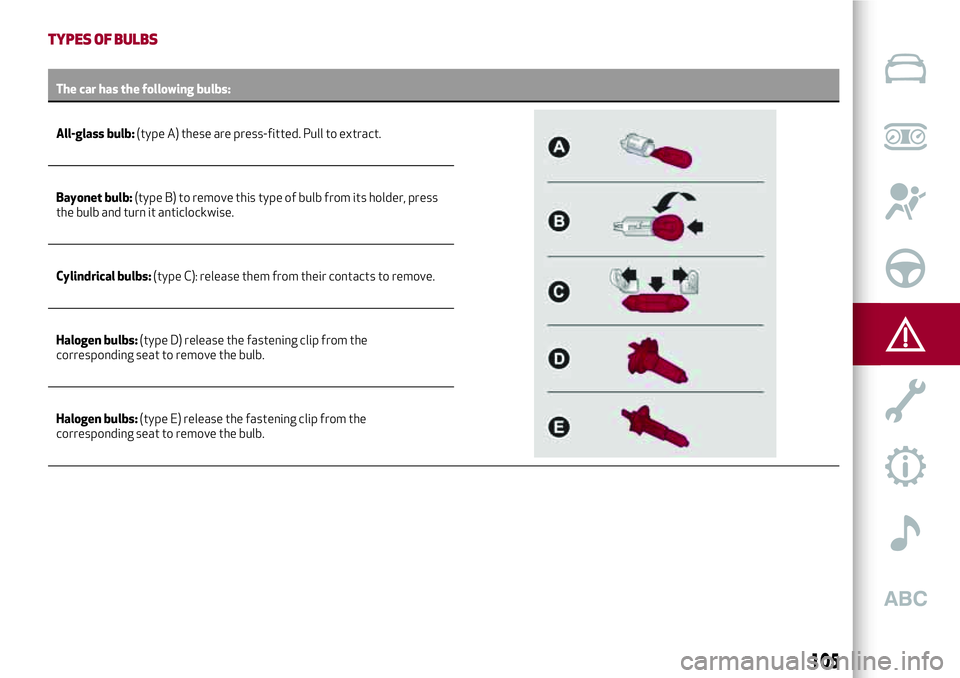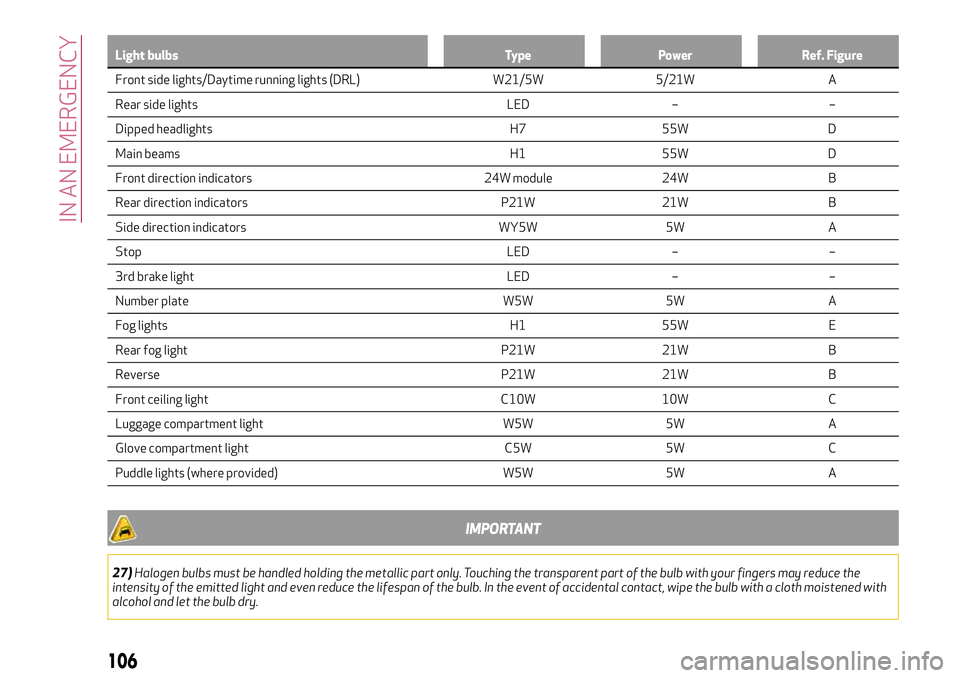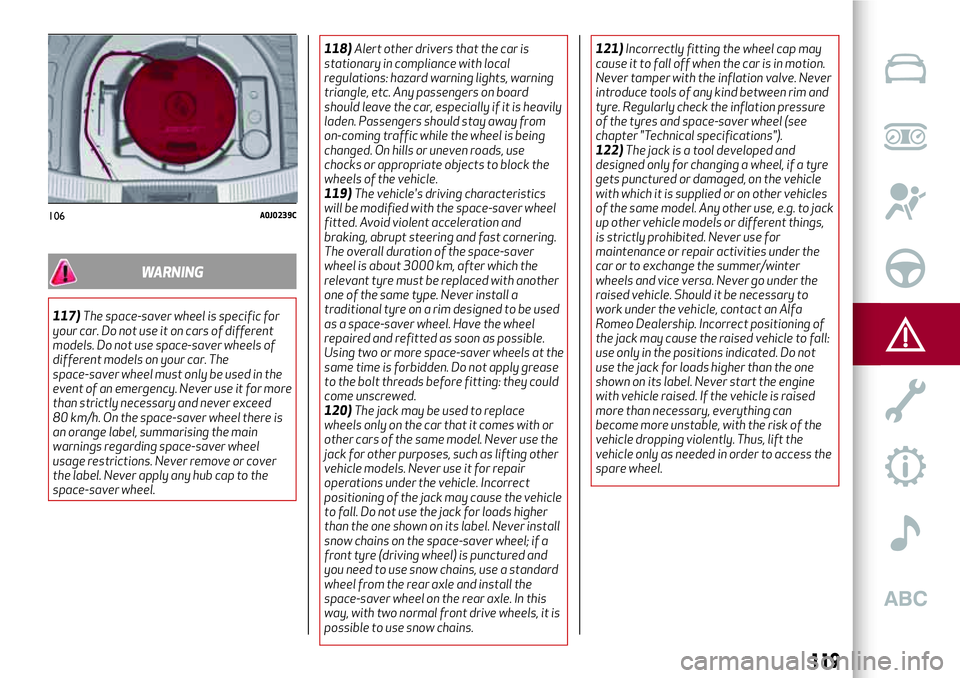ESP Alfa Romeo MiTo 2020 Owner handbook (in English)
[x] Cancel search | Manufacturer: ALFA ROMEO, Model Year: 2020, Model line: MiTo, Model: Alfa Romeo MiTo 2020Pages: 212, PDF Size: 5.18 MB
Page 107 of 212

TYPES OF BULBS
The car has the following bulbs:
All-glass bulb:(type A) these are press-fitted. Pull to extract.
Bayonet bulb:(type B) to remove this type of bulb from its holder, press
the bulb and turn it anticlockwise.
Cylindrical bulbs:(type C): release them from their contacts to remove.
Halogen bulbs:(type D) release the fastening clip from the
corresponding seat to remove the bulb.
Halogen bulbs:(type E) release the fastening clip from the
corresponding seat to remove the bulb.
105
Page 108 of 212

Light bulbs Type Power Ref. Figure
Front side lights/Daytime running lights (DRL) W21/5W 5/21W A
Rear side lights LED – –
Dipped headlights H7 55W D
Main beams H1 55W D
Front direction indicators 24W module 24W B
Rear direction indicators P21W 21W B
Side direction indicators WY5W 5W A
Stop LED – –
3rd brake light LED – –
Number plate W5W 5W A
Fog lights H1 55W E
Rear fog light P21W 21W B
Reverse P21W 21W B
Front ceiling light C10W 10W C
Luggage compartment light W5W 5W A
Glove compartment light C5W 5W C
Puddle lights (where provided) W5W 5W A
IMPORTANT
27)Halogen bulbs must be handled holding the metallic part only. Touching the transparent part of the bulb with your fingers may reduce the
intensity of the emitted light and even reduce the lifespan of the bulb. In the event of accidental contact, wipe the bulb with a cloth moistened with
alcohol and let the bulb dry.
106
IN AN EMERGENCY
Page 113 of 212

The number identifying the electricalcomponent corresponding to each fuse is
shown on the back of the cover. After
replacing the fuse, make sure you close
cover 2 on the fuse box.
Dashboard fuse box
To access the fuses fig. 93 lower the flap
1 fig. 92, with a hand hold the cover 2 in
the area indicated in figure and remove it
operating in the sense indicated by the
arrow, in order to disengage internal
retainers 3 first, and then the tabs 4.
90A0J0126C
91A0J0417C92A0J0334C
93A0J0205C
111
Page 121 of 212

WARNING
117)The space-saver wheel is specific for
your car. Do not use it on cars of different
models. Do not use space-saver wheels of
different models on your car. The
space-saver wheel must only be used in the
event of an emergency. Never use it for more
than strictly necessary and never exceed
80 km/h. On the space-saver wheel there is
an orange label, summarising the main
warnings regarding space-saver wheel
usage restrictions. Never remove or cover
the label. Never apply any hub cap to the
space-saver wheel.118)Alert other drivers that the car is
stationary in compliance with local
regulations: hazard warning lights, warning
triangle, etc. Any passengers on board
should leave the car, especially if it is heavily
laden. Passengers should stay away from
on-coming traffic while the wheel is being
changed. On hills or uneven roads, use
chocks or appropriate objects to block the
wheels of the vehicle.
119)The vehicle's driving characteristics
will be modified with the space-saver wheel
fitted. Avoid violent acceleration and
braking, abrupt steering and fast cornering.
The overall duration of the space-saver
wheel is about 3000 km, after which the
relevant tyre must be replaced with another
one of the same type. Never install a
traditional tyre on a rim designed to be used
as a space-saver wheel. Have the wheel
repaired and refitted as soon as possible.
Using two or more space-saver wheels at the
same time is forbidden. Do not apply grease
to the bolt threads before fitting: they could
come unscrewed.
120)The jack may be used to replace
wheels only on the car that it comes with or
other cars of the same model. Never use the
jack for other purposes, such as lifting other
vehicle models. Never use it for repair
operations under the vehicle. Incorrect
positioning of the jack may cause the vehicle
to fall. Do not use the jack for loads higher
than the one shown on its label. Never install
snow chains on the space-saver wheel; if a
front tyre (driving wheel) is punctured and
you need to use snow chains, use a standard
wheel from the rear axle and install the
space-saver wheel on the rear axle. In this
way, with two normal front drive wheels, it is
possible to use snow chains.121)Incorrectly fitting the wheel cap may
cause it to fall off when the car is in motion.
Never tamper with the inflation valve. Never
introduce tools of any kind between rim and
tyre. Regularly check the inflation pressure
of the tyres and space-saver wheel (see
chapter "Technical specifications").
122)The jack is a tool developed and
designed only for changing a wheel, if a tyre
gets punctured or damaged, on the vehicle
with which it is supplied or on other vehicles
of the same model. Any other use, e.g. to jack
up other vehicle models or different things,
is strictly prohibited. Never use for
maintenance or repair activities under the
car or to exchange the summer/winter
wheels and vice versa. Never go under the
raised vehicle. Should it be necessary to
work under the vehicle, contact an Alfa
Romeo Dealership. Incorrect positioning of
the jack may cause the raised vehicle to fall:
use only in the positions indicated. Do not
use the jack for loads higher than the one
shown on its label. Never start the engine
with vehicle raised. If the vehicle is raised
more than necessary, everything can
become more unstable, with the risk of the
vehicle dropping violently. Thus, lift the
vehicle only as needed in order to access the
spare wheel.
106A0J0239C
119
Page 134 of 212

Thousands of miles9 182736455463728190
Thousands of kilometres15 30 45 60 75 90 105 120 135 150
Years12345678910
Replace filter inside the pressure
regulator (1.4 Turbo Petrol/LPG
120 HP version)
Replace paper filter (LPG in gaseous
state) (1.4 Turbo Petrol/LPG 120 HP
version)
Change the brake fluid(7)
Replace the passenger compartment
cleaner (6) (o) (●)
(7) The brake fluid replacement has to be done every 2 years, irrespective of the mileage.
(6) If the vehicle is used in dusty areas, this cleaner must be replaced every 15,000 km.
(o) Recommended operations
(●) Mandatory operations
132
SERVICING AND MAINTENANCE
Page 137 of 212

Thousands of miles12 24 36 48 60 72 84 96 108 120
Thousands of kilometres20 40 60 80 100 120 140 160 180 200
Years12345678910
Replace accessory drive belt/s(3)
Replace fuel filter cartridge(4)
Replace air cleaner cartridge(5)
Change the brake fluid(6)
Replace the passenger compartment
cleaner(5) (o) (●)
(3) Areas that are not dusty: recommended maximum mileage 120,000 km. The belt must be replaced every 6 years, regardless of distance travelled.
Dusty areas and/or demanding use of the car (cold climates, town use, long periods of idling): advised maximum mileage 60,000 km. The belt must
be replaced every 4 years, regardless of distance travelled.
(4) If the vehicle runs on fuel with quality below the relevant European specification, this filter must be replaced every 20,000 km
(5) If the vehicle is used in dusty areas, this cleaner must be replaced every 20,000 km.
(6) The brake fluid replacement has to be done every 2 years, irrespective of the mileage.
(o) Recommended operations
(●) Mandatory operations
135
Page 156 of 212

ENGINE
GENERAL INFORMATION Turbo TwinAir 105 HP Turbo TwinAir 100 HP(*)
Engine code 199B6000 199B7000
CycleOtto Otto
Number and position of cylinders 4 in line 4 in line
Piston bore and stroke (mm) 80.5 × 86 72.0 × 84.0
Total displacement (cm³) 875 875
Compression ratio 10 10
NATURAL DYNAMIC
Maximum power (EC) (kW) 72 77 73.5
Maximum power (EEC) (HP) 98 105 100
corresponding engine speed (rpm) 5750 5500 5500
Maximum torque (EC) (Nm) 120 145 145
Maximum torque (EC) (kgm) 12.2 14.8 14.8
corresponding engine speed (rpm) 1750 2000 2100
Spark plugs NGK ILKR9G8 NGK ILKR9G8
FuelUnleaded petrol 95 R.O.N. (EN
228 specifications)Unleaded petrol 95 R.O.N. (EN
228 specifications)
(*) Version for specific markets
154
TECHNICAL SPECIFICATIONS
Page 157 of 212

GENERAL INFORMATION 1.4 Petrol 8V 78 HP 1.4 Turbo Petrol/LPG 120 HP
Engine code 350A1000 198A4000
Cycle Otto Otto
Number and position of cylinders 4 in line 4 in line
Piston bore and stroke (mm) 72.0 × 84.0 72.0 × 84.0
Total displacement (cm³) 1368 1368
Compression ratio 11.1 9.8
LPG PETROL
Maximum power (EC) (kW) 57 88 88
Maximum power (EEC) (HP) 78 120 120
corresponding engine speed (rpm) 6000 5000 5000
Maximum torque (EC) (Nm) 115 206 206
Maximum torque (EC) (kgm) 11.7 21 21
corresponding engine speed (rpm) 3000 1750 2000
Spark plugs NGK ZKR7AI-8 NGK IKR9J8
Fuel Unleaded petrol 95 R.O.N.
(EN 228 specifications)LPG
(EN589Unleaded
petrol
95 R.O.N. (EN
228 specifications)
155
specification)
Page 158 of 212

GENERAL INFORMATION 1.4 Turbo MultiAir 135 HP 1.4 Turbo Multi Air 135/140 HP TCT
Engine code 955A2000955A7000 (*)
955B1000 (**)
Cycle Otto Otto
Number and position of cylinders 4 in line 4 in line
Piston bore and stroke (mm) 72.0 × 84.0 72.0 × 84.0
Total displacement (cm³) 1368 1368
Compression ratio 9.8 9.8
Maximum power (EC) (kW) 99 99 (*) / 103 (**)
Maximum power (EEC) (HP) 135 135 (*) / 140 (**)
corresponding engine speed (rpm) 5000 5000
NATURAL DYNAMIC NATURAL DYNAMIC
Maximum torque (EC) (Nm) 190 206 230 250
Maximum torque (EC) (kgm) 19.3 21 23.4 25.5
corresponding engine speed (rpm) 4250 1750 2250 2500
Spark plugs NGK IKR9F8 NGK IKR9J8
FuelUnleaded petrol 95 R.O.N. (EN
228 specifications)Unleaded petrol 95 R.O.N. (EN
228 specifications)
(*) 1.4 Turbo Multi Air 135 HP TCT version (where provided)
(**) 1.4 Turbo Multi Air 140 HP TCT version
156
TECHNICAL SPECIFICATIONS
Page 159 of 212

GENERAL INFORMATION 1.4 Turbo MultiAir 170 HP 1.4 Turbo MultiAir 170 HP TCT
Engine code 940A2000 940A2000
Cycle Otto Otto
Number and position of cylinders 4 in line 4 in line
Piston bore and stroke (mm) 72.0 × 84.0 72.0 × 84.0
Total displacement (cm³) 1368 1368
Compression ratio 9.8 9.8
Maximum power (EC) (kW) 125 125
Maximum power (EEC) (HP) 170 170
corresponding engine speed (rpm) 5000 5000
NATURAL DYNAMIC NATURAL DYNAMIC
Maximum torque (EC) (Nm) 230 250 230 250
Maximum torque (EC) (kgm) 23.4 25.5 23.4 25.5
corresponding engine speed (rpm) 2250 2500 2250 2500
Spark plugs NGK IKR9J8 NGK IKR9J8
FuelUnleaded petrol 95 R.O.N. (EN
228 specifications)Unleaded petrol 95 R.O.N. (EN
228 specifications)
157